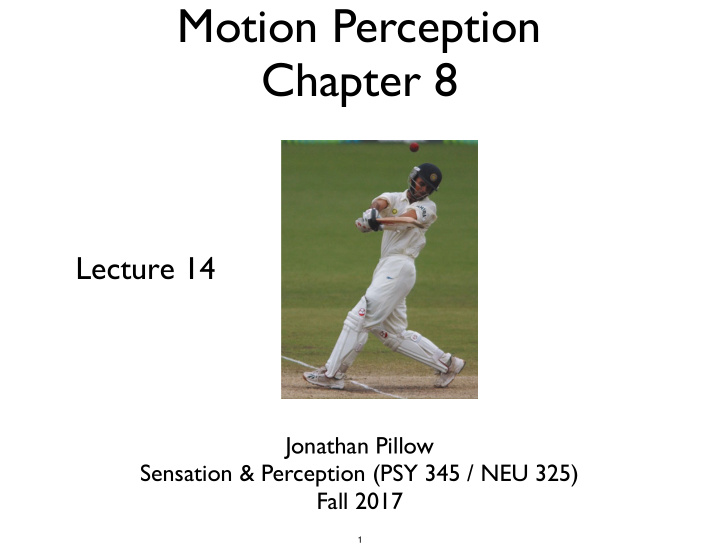



Motion Perception Chapter 8 Lecture 14 Jonathan Pillow Sensation & Perception (PSY 345 / NEU 325) Fall 2017 1
(chap 6 leftovers) Defects in Stereopsis Strabismus • eyes not aligned, so diff images fall on the fovea • If not corrected at an early age, stereopsis will not develop stereoblindness : inability to use binocular disparity as a depth cue. 2
Depth Illusions Müller-Lyer Illusion http://www.michaelbach.de/ot/sze_muelue/index.html 3
In which image are the two horizontal lines the same length? (Ans: second from left) 4
Two figures are the same size 5
“Terror Subterra” 6
“Terror Subterra” 7
Depth / Size illusion • all 3 cars take up the same space in the image + on your retina! 8
Binocular Rivalry 9
Two stimuli battle for dominance of the percept 10
Chapter 6 Summary: • monocular depth cues • binocular depth cues (vergence, disparity) • horopter • crossed / uncrossed disparities • free fusing • random dot stereogram • stereoscope • “correspondence problem” • panum’s fusional area • strabismus / stereoblindness • binocular rivalry (in book) 11
Motion Perception Chapter 8 12
Main point of this chapter: Motion = Orientation in Space-Time time space 13
which motion is faster? slow fast time time space space 14
Real vs. Apparent motion Apparent motion - motion percept that results from rapid display of stationary images in different locations apparent “real” (movies, flip-books) time time space space Q: why don’t we notice the difference? 15
How does the nervous system encode motion? What makes a Motion Receptive Field? Answer: a surprisingly simple neural circuit called a “Reichardt detector” 16
delay line simple Reichardt summing neuron detector 17
Reichardt detector in space-time excitatory first inhibitory RF time second RF space 2nd neuron has a spatially separated Receptive Field (RF), and a shorter temporal delay 18
Smoother Reichardt detector excitatory inhibitory time space Like an oriented V1 receptive field, but oriented in space-time! 19
Reichardt detectors respond to real and apparent motion excitatory inhibitory time space 20
Figure 7.3 Constructing a neural circuit for the detection of rightward motion (Part 1) 21
Figure 7.3 Constructing a neural circuit for the detection of rightward motion (Part 2) 22
Correspondence problem (motion): • problem of knowing the correspondence between features in successive frames (which points in frame 1 are the same objects in frame 2?) Clockwise or Counter-clockwise rotation? (web demo) http://sites.sinauer.com/wolfe3e/chap8/correspondenceF.htm 23
• Aperture problem : when a moving object is viewed through an aperture, the direction of motion may be ambiguous 24
• Aperture problem : when a moving object is viewed through an aperture, the direction of motion may be ambiguous 25
• Aperture problem : when a moving object is viewed through an aperture, the direction of motion may be ambiguous 26
• Aperture problem : • this is a problem because each neuron only sees the scene through a small aperture (its receptive field!) • how can the brain figure out the “global” direction of motion? 27
aperture problem / correspondence problem http://sites.sinauer.com/wolfe4e/wa08.02.html 28
building a global motion detector 29
Motion aftereffect (MAE) : The illusion of motion that occurs after prolonged exposure to a moving stimulus http://www.michaelbach.de/ot/mot-adapt/index.html 30
Motion after-effect • Always gives rise to motion in the opposite direction of the adapting motion • Also known as: “waterfall illusion” - stare at a waterfall; stationary objects will then appear to move upwards. • evidence for “opponent channels” in processing motion 31
Interocular transfer : The transfer of an effect (such as adaptation) from one eye to another • MAE: exhibits interocular transfer Q: What does this tell us about where in the brain motion is computed? • Remember: Input from both eyes is combined in area V1 32
“Motion After-Effect” 33
“Motion After-Effect” 34
Recommend
More recommend